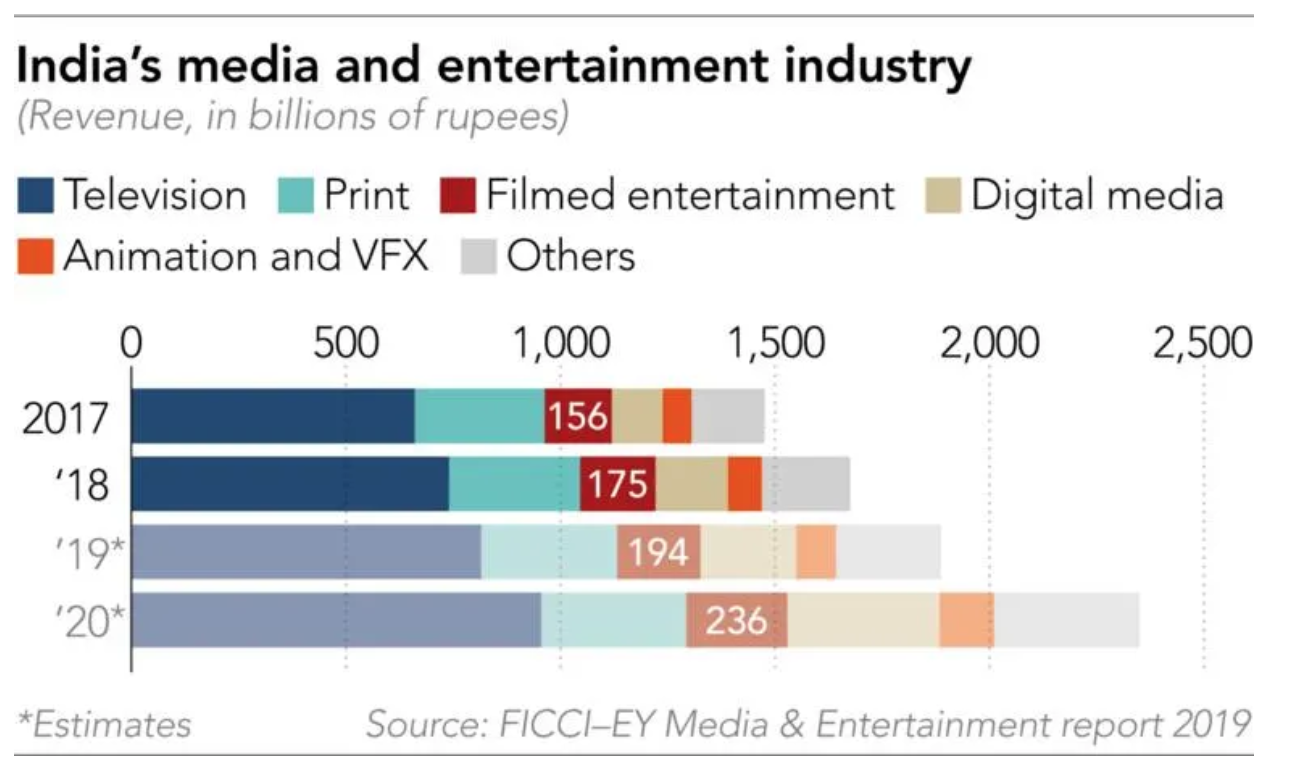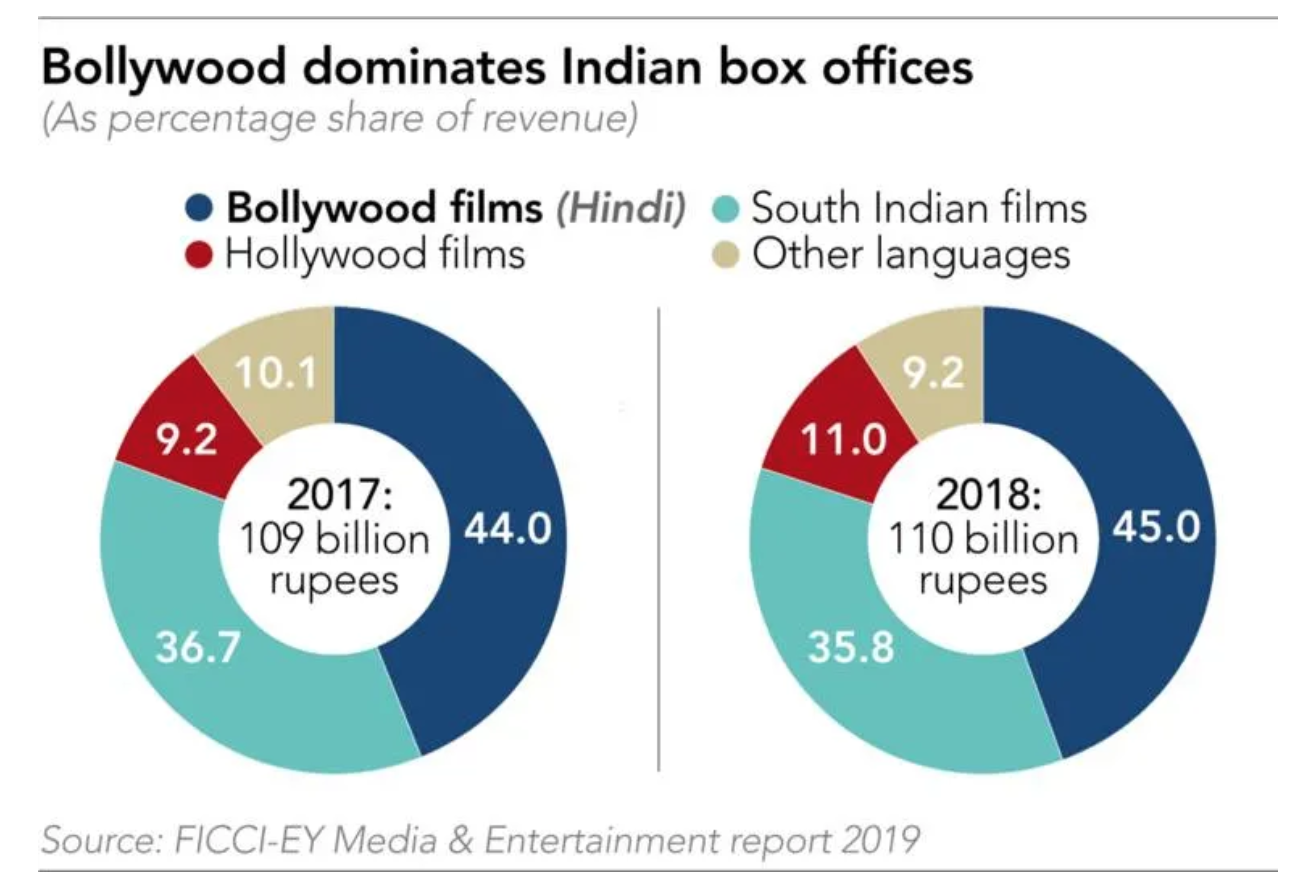Shikha Nalwa, a homemaker from the northern Indian city of Chandigarh, had been looking forward to seeing “Gulabo Sitabo”. The comedy-drama starring Bollywood superstar Amitabh Bachchan was expected to be a blockbuster.
But before “Gulabo Sitabo” hit 2,000 theaters in April, the coronavirus outbreak hit India — and a nationwide lockdown was imposed. Rather than head to the theater, movie fans like Nalwa had to settle for watching “Gulabo Sitabo” on Amazon Prime Video, two months after its originally scheduled release date.
For Nalwa, watching at home did not spoil her enjoyment.
“Though the movie is a bit slow-paced in parts, it has an interesting narration,” she said. In the film, Bachchan plays a disreputable landlord named Mizra who wants to evict tenants from his run-down mansion in order to sell it. “[His] Tom-and-Jerry like fight with tenant Baankey was a major highlight for me,” Nalwa added.
The most interesting storyline in Indian film right now, though, might be what is happening to the industry itself. The ongoing lockdown is shaking up the long-standing order in new film distribution, which connects studios, distributors, and nearly 10,000 cinemas across the country.
Some studios will be hoping that other moviegoers are equally willing to swap the big screen for computer screens for new releases via online services — including Amazon, Netflix, and a clutch of local players.
But some filmmakers are holding out, refusing online premieres while movie theater operators are vehemently opposed to the digital disruptions. The film industry, the bedrock of India’s entertainment culture, is at a crossroads as to whether the COVID-19 pandemic will see an increase in digital delivery.
India is a country of movie lovers. Between 1,500 and 2,000 films, in more than 20 local languages, are released each year. And millions of fans flock to theaters every Friday, the most popular day for new releases.
But on March 25, the government instituted a countrywide lockdown to combat the coronavirus pandemic. The lockdown has been extended three times, and though some businesses have been allowed to reopen since June 8, the government has indicated that movie theaters will be among the last allowed to do so.
With the number of coronavirus infections topping 1.5 million — the third-highest total in the world — a growing number of film studios feel they cannot keep waiting for brick-and-mortar theaters to reopen.
“Gulabo Sitabo” — whose star Bachchan himself tested positive for coronavirus this month — is a prime example of this dilemma.
No official figures are available, but according to estimates, the film’s budget was USD 5.3 million to USD 5.9 million and the distribution rights were sold to Amazon for between USD 7.9 million and USD 8.6 million.
“We are not a big corporate house. We make one film at a time. We sell it and release it, and then put the money back into our next film,” Forbes quoted co-producer Ronnie Lahiri as saying. “We also have to pay all our technicians. There is a lot of money riding on this.”
India had approximately 9,600 movie theaters, including 2,950 multiplexes, as of last year. The country’s film industry was estimated to be worth INR 194.2 billion (USD 2.5 billion) in 2019, according to the FICCI-EY Media & Entertainment report. Domestic theatrical releases account for INR 110 billion, or 57% of total earnings.

The coronavirus pandemic, however, has forced more studios to follow Lahiri’s lead and release their films online, a boon for online platforms.
Management consultancy KPMG predicted last September that India’s online video subscriber base would increase from 300 million at the time to 500 million by 2023. Girish Menon, partner and head of media and entertainment at KPMG in India, says India is now poised to reach that mark much sooner.
“With a paucity of out-of-home entertainment options and continued efforts [by video streaming platforms] to offer fresh and exclusive content to consumers when there is no original content on TV, this has led to an acceleration of consumption on video platforms,” he said.
Stars like Akshay Kumar — the only Indian to feature in Forbes’ list of the “World’s 100 Highest-Paid Celebrities” for 2020 — are helping sell this streaming shift to fans. His latest film, “Laxmmi Bomb,” a Hindi-language comedy-horror co-starring actor Kiara Advani was originally set to be released in theaters on May 22, but it was postponed due to the pandemic.
Then, on June 29, Disney Plus Hotstar announced at a virtual news conference that it would release the film, though it did not say when. “Watch First day First show of #LaxmmiBomb from the comfort of your homes,” Kumar wrote on social media.
Disney also hoped to recreate the fanfare of a conventional in-theater release virtually.
“We thought, why not use the opportunity of the pandemic to create a big, alternative world of exhibition, and create a network of virtual theaters — private theaters in everybody’s homes,” said Uday Shankar, president of The Walt Disney Company APAC and chairman of The Walt Disney Company India. “We should not see this as a short-term tactical compromise. We should see this as a very big leap for the industry,” he said.
“Sadak 2,” the sequel to a 1991 blockbuster, will also premiere on Disney Plus Hotstar. Mahesh Bhatt, the director of the original film, returned to helm the sequel. It is one of the most anticipated films of the year, as it is the first time that the veteran director will be working with his younger daughter, Alia Bhatt, the highest-paid female actor in India, who has a starring role in the film.

Netflix, meanwhile, will soon premiere “Gunjan Saxena: The Kargil Girl,” a biographical film starring Janhvi Kapoor as Gunjan Saxena, who gained fame as the first Indian female air force pilot to see combat during the 1999 Kargil War between India and Pakistan.
Not all producers are rushing to release their movies online, however.
Vishal Maheshwari, former India head of Hong Kong-based streaming platform Viu, told the Nikkei Asian Review that skipping theatrical release for digital release is only feasible for films made on a budget of USD 4 million to USD 13 million.
Digital platforms, he said, cannot pay more than that for streaming rights. “I don’t think big-budget movies can afford to release on digital media for a longer period and move away from theater releases,” he said.
For this reason, makers of some high-profile movies have decided to wait for theaters to reopen.
One such title is Akshay Kumar’s cop drama “Sooryavanshi,” sports drama “83,” based on the Indian cricket team’s maiden World Cup win in 1983, a remake of 1995 superhit “Coolie No. 1” and “Radhe,” starring Salman Khan, one of Bollywood’s biggest stars.
But even though some of the biggest film events of the year are holding out for a traditional release, theater operators are not happy that a number of other productions have opted for streaming. PVR and Inox, two of the biggest multiplex chains in India, have voiced their displeasure with the trend.

“We are very disappointed with some of our producers deciding to go straight to digital platforms,” Kamal Gainchandani, CEO of PVR Picture, a distribution arm of PVR, was quoted as saying by Press Trust of India. “[W]e believe that the theatrical release is the best way for audiences to experience the labor and creative genius of our filmmakers.”
PVR, which operates 176 movie theaters in 71 cities across India, posted a net loss of INR 744.9 million (USD 10 million) in the January to March quarter, down from a profit of INR 469.4 million in the same period the previous year. “We were doing great [in January and February] and [in] March effectively we were shut down, so clearly that had a big impact on the operating profitability,” CFO Nitin Sood said during an earnings call on June 9.
Inox expressed “extreme displeasure and disappointment,” and said the shift to streaming was “disturbing … alarming and disconcerting.” The statement, which came after the announcement that “Gulabo Sitabo” would be released digitally, called the film’s producers “fair-weather friends” and warned of “retributive measures.”
The Producers Guild of India released a statement a day later lamenting the threatening nature of Inox’s statement. It noted that while theatrical release remains the first choice of producers, the lockdown has brought about an unprecedented crisis, and they are compelled to fall back upon alternative avenues to recover costs.
It further pointed out that even when theaters reopen, occupancy will be low owing to the physical distancing measures required to check the spread of the coronavirus. This, the statement underlined, will result in lower revenue per show.
While theaters and multiplex owners continue to struggle amid the prolonged lockdown, streaming platforms have seen their business flourish.
Karan Bedi, CEO at MX Player, a streaming platform owned by Mumbai-based news and entertainment conglomerate The Times Group, said viewership on its network increased two and a half times during the lockdown.
ALTBalaji, another Indian platform, said its daily average viewers rose to 17,000 from 10,600 before the lockdown. An internal report by rival ZEE5, meanwhile, said the video streaming industry grew 60% during the lockdown, compared with the previous growth rate of 20% to 25%. Average viewership on digital platforms, it added, have increased by 87% since the lockdowns were instituted.
For many of these platforms, a focus on regional content has helped drive growth. MX Player, for example, offers content in 12 Indian languages. Amazon Prime Video, ZEE5, and ALTBalaji, are also among leading content providers in regional languages.
About a dozen movies made in Tamil, Telugu, and Kannada — the languages spoken in the southern Indian states of Tamil Nadu, Andhra Pradesh, and Karnataka, respectively — have been released or confirmed for straight-to-digital release. Online platforms also offer dubbed content. Amazon Prime Video has released “Gulabo Sitabo” in 15 languages.
But will streaming players be able to hang on to their lockdown gains?
Uday Sodhi, former business head of local video streaming platform SonyLIV, believes so. The streaming industry had been growing anyway, he said, and the lockdown only accelerated that trend.
Video streaming platforms “may not grow at the same pace when COVID-19 goes, but I don’t think the habit is going to change,” Sodhi said. “As [platforms] will keep pushing a lot of original content and new movie releases, viewers will be glued to it.”
Nalwa, the homemaker from Chandigarh, is one of those embracing the shift to streaming. “It was good to see new release straight to home screens, all thanks to the COVID-19 lockdown,” she said.
This article first appeared on Nikkei Asian Review. It’s republished here as part of 36Kr’s ongoing partnership with Nikkei. 36Kr is KrASIA’s parent company.


